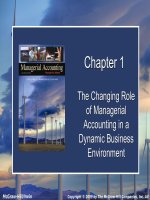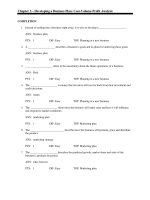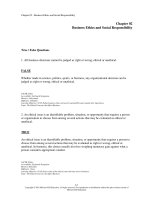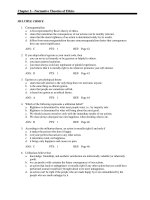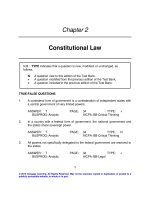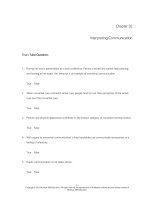Managerial accounting creating value in a dynamic business environment 10th edition hilton test bank
Bạn đang xem bản rút gọn của tài liệu. Xem và tải ngay bản đầy đủ của tài liệu tại đây (3.84 MB, 126 trang )
Chapter 02
Basic Cost Management Concepts
True / False Questions
1.
Inventoriable costs are expensed when incurred.
True
2.
Finished goods inventory is ordinarily held for sale by a manufacturing company.
True
3.
False
Indirect labor is not a component of manufacturing overhead.
True
4.
False
False
The following equation—Beginning finished goods + cost of goods manufactured - ending finished
goods—is used to calculate cost of goods sold during the period.
True
5.
False
A suitable cost driver for the amount of direct materials used is the number of direct labor hours
worked.
True
False
2-1
Copyright © 2014 McGraw-Hill Education. All rights reserved. No reproduction or distribution without the prior written consent of
McGraw-Hill Education.
Multiple Choice Questions
6.
Which of the following statements is true?
A. The word "cost" has the same meaning in all situations in which it is used.
B. Cost data, once classified and recorded for a specific application, are appropriate for use in any
application.
C. Different cost concepts and classifications are used for different purposes.
D. All organizations incur the same types of costs.
E. Costs incurred in one year are always meaningful in the following year.
7.
Product costs are:
A. expensed when incurred.
B. inventoried.
C. treated in the same manner as period costs.
D. treated in the same manner as advertising costs.
E. subtracted from cost of goods sold.
8.
Which of the following is a product cost?
A. Glass in an automobile.
B. Advertising.
C. The salary of the vice president-finance.
D. Rent on a factory.
E. Advertising and rent on a factory.
2-2
Copyright © 2014 McGraw-Hill Education. All rights reserved. No reproduction or distribution without the prior written consent of
McGraw-Hill Education.
9.
Which of the following would not be classified as a product cost?
A. Direct materials.
B. Direct labor.
C. Indirect materials.
D. Insurance on a manufacturing plant.
E. Sales commissions.
10. The accounting records of Georgia Company revealed the following costs: direct materials used,
$250,000; direct labor, $425,000; manufacturing overhead, $375,000; and selling and administrative
expenses, $220,000. Georgia's product costs total:
A. $1,050,000.
B. $830,000.
C. $895,000.
D. $1,270,000.
E. None of the other answers are correct.
11. Costs that are expensed when incurred are called:
A. product costs.
B. direct costs.
C. inventoriable costs.
D. period costs.
E. indirect costs.
2-3
Copyright © 2014 McGraw-Hill Education. All rights reserved. No reproduction or distribution without the prior written consent of
McGraw-Hill Education.
12. Which of the following is a period cost?
A. Direct material.
B. Advertising expense.
C. Indirect labor.
D. Miscellaneous supplies used in production activities.
E. Advertising expense and indirect labor.
13. Which of the following is not a period cost?
A. Legal costs.
B. Public relations costs.
C. Sales commissions.
D. Wages of assembly-line workers.
E. The salary of a company's chief financial officer (CFO).
14. The accounting records of Reynolds Corporation revealed the following selected costs: Sales
commissions, $65,000; plant supervision, $190,000; and administrative expenses, $185,000.
Reynolds's period costs total:
A. $250,000.
B. $440,000.
C. $375,000.
D. $255,000.
E. $185,000.
2-4
Copyright © 2014 McGraw-Hill Education. All rights reserved. No reproduction or distribution without the prior written consent of
McGraw-Hill Education.
15. Yang Corporation recently computed total product costs of $567,000 and total period costs of
$420,000, excluding $35,000 of sales commissions that were overlooked by the company's
administrative assistant. On the basis of this information, Yang's income statement should reveal
operating expenses of:
A. $35,000.
B. $420,000.
C. $455,000.
D. $567,000.
E. $602,000.
16. Which of the following entities would most likely have raw materials, work in process, and finished
goods?
A. Exxon Corporation.
B. Macy's Department Store.
C. Wendy's.
D. Southwest Airlines.
E. Columbia University.
17. Selling and administrative expenses would likely appear on the balance sheet of:
A. The Gap.
B. Texas Instruments.
C. Turner Broadcasting System.
D. All of these firms.
E. None of these firms.
2-5
Copyright © 2014 McGraw-Hill Education. All rights reserved. No reproduction or distribution without the prior written consent of
McGraw-Hill Education.
18. Which of the following inventories would a discount retailer such as Wal-Mart report as an asset?
A. Raw materials.
B. Work in process.
C. Finished goods.
D. Merchandise inventory.
E. All of the other answers are correct.
19. Which of the following inventories would a company ordinarily hold for sale?
A. Raw materials.
B. Work in process.
C. Finished goods.
D. Raw materials and finished goods.
E. Work in process and finished goods.
20. Which of the four items listed below is not a type of production process?
A. Batch.
B. Job Shop.
C. Continuous Flow.
D. Job Flow.
2-6
Copyright © 2014 McGraw-Hill Education. All rights reserved. No reproduction or distribution without the prior written consent of
McGraw-Hill Education.
21. Which type of production process is ideal for a low production volume and one of a kind
products?
A. Batch.
B. Continuous Flow.
C. Job Shop.
D. Assembly.
22. Mideast Motors manufactures automobiles. Which of the following would not be classified as direct
materials by the company?
A. Wheel lubricant.
B. Tires.
C. Interior leather.
D. CD player.
E. Sheet metal used in the automobile's body.
23. Which of the following employees of a commercial printer/publisher would be classified as direct
labor?
A. Book binder.
B. Plant security guard.
C. Sales representative.
D. Plant supervisor.
E. Payroll supervisor.
2-7
Copyright © 2014 McGraw-Hill Education. All rights reserved. No reproduction or distribution without the prior written consent of
McGraw-Hill Education.
24. Lake Appliance produces washers and dryers in an assembly-line process. Labor costs incurred
during a recent period were: corporate executives, $500,000; assembly-line workers, $180,000;
security guards, $45,000; and plant supervisor, $110,000. The total of Lake's direct labor cost was:
A. $110,000.
B. $180,000.
C. $155,000.
D. $235,000.
E. $735,000.
25. Which of the following employees would not be classified as indirect labor?
A. Plant Custodian.
B. Salesperson.
C. Assembler of wooden furniture.
D. Plant security guard.
E. Salesperson and assembler of wooden furniture.
26. Depreciation of factory equipment would be classified as:
A. operating cost.
B. "other" cost.
C. manufacturing overhead.
D. period cost.
E. administrative cost.
2-8
Copyright © 2014 McGraw-Hill Education. All rights reserved. No reproduction or distribution without the prior written consent of
McGraw-Hill Education.
27. Which of the following costs is not a component of manufacturing overhead?
A. Indirect materials.
B. Factory utilities.
C. Factory equipment.
D. Indirect labor.
E. Property taxes on the manufacturing plant.
28. The accounting records of Diego Company revealed the following costs, among others:
Costs that would be considered in the calculation of manufacturing overhead total:
A. $149,000.
B. $171,000.
C. $186,000.
D. $442,000.
E. None of the other answers are correct.
2-9
Copyright © 2014 McGraw-Hill Education. All rights reserved. No reproduction or distribution without the prior written consent of
McGraw-Hill Education.
29. Which of the following statements is(are) correct?
A. Overtime premiums should be treated as a component of manufacturing overhead.
B. Overtime premiums should be treated as a component of direct labor.
C. Idle time should be treated as a component of direct labor.
D. Idle time should be accounted for as a special type of loss.
E. Overtime premiums should be treated as a component of direct labor and idle time should be
treated as a component of direct labor.
30. Conversion costs are:
A. direct material, direct labor, and manufacturing overhead.
B. direct material and direct labor.
C. direct labor and manufacturing overhead.
D. prime costs.
E. period costs.
31. Prime costs are comprised of:
A. direct materials and manufacturing overhead.
B. direct labor and manufacturing overhead.
C. direct materials, direct labor, and manufacturing overhead.
D. direct materials and direct labor.
E. direct materials and indirect materials.
2-10
Copyright © 2014 McGraw-Hill Education. All rights reserved. No reproduction or distribution without the prior written consent of
McGraw-Hill Education.
32. Which of the following statements is true?
A. Product costs affect only the balance sheet.
B. Product costs affect only the income statement.
C. Period costs affect only the balance sheet.
D. Neither product costs nor period costs affect the Statement of Retained Earnings. This can also
be a true statement if the period costs were prepaid (i.e., prepaid advertising, depreciation).
E. Product costs eventually affect both the balance sheet and the income statement.
33. In a manufacturing company, the cost of goods completed during the period would include which
of the following elements?
A. Raw materials used.
B. Beginning finished goods inventory.
C. Marketing costs.
D. Depreciation of delivery trucks.
E. All of the other answers are correct.
34. Which of the following equations is used to calculate cost of goods sold during the period?
A. Beginning finished goods + cost of goods manufactured + ending finished goods.
B. Beginning finished goods - ending finished goods.
C. Beginning finished goods + cost of goods manufactured.
D. Beginning finished goods + cost of goods manufactured - ending finished goods.
E. Beginning finished goods + ending finished goods - cost of goods manufactured.
2-11
Copyright © 2014 McGraw-Hill Education. All rights reserved. No reproduction or distribution without the prior written consent of
McGraw-Hill Education.
35. Work-in-process inventory is composed of:
A. direct material and direct labor.
B. direct labor and manufacturing overhead.
C. direct material and manufacturing overhead.
D. direct material, direct labor, and manufacturing overhead.
E. direct material only.
36. Holden Industries began July with a finished-goods inventory of $48,000. The finished-goods
inventory at the end of July was $56,000 and the cost of goods sold during the month was
$125,000. The cost of goods manufactured during July was:
A. $104,000.
B. $125,000.
C. $117,000.
D. $133,000.
E. None of the other answers are correct.
2-12
Copyright © 2014 McGraw-Hill Education. All rights reserved. No reproduction or distribution without the prior written consent of
McGraw-Hill Education.
37. Carolina Plating Company reported a cost of goods manufactured of $520,000, with the firm's yearend balance sheet revealing work in process and finished goods of $70,000 and $134,000,
respectively. If supplemental information disclosed raw materials used in production of $80,000,
direct labor of $140,000, and manufacturing overhead of $240,000, the company's beginning work
in process must have been:
A. $130,000.
B. $10,000.
C. $66,000.
D. $390,000.
E. None of the other answers are correct.
38. The accounting records of Bronco Company revealed the following information:
Bronco's cost of goods manufactured is:
A. $519,000.
B. $522,000.
C. $568,000.
D. $571,000.
E. None of the other answers are correct.
2-13
Copyright © 2014 McGraw-Hill Education. All rights reserved. No reproduction or distribution without the prior written consent of
McGraw-Hill Education.
39. The accounting records of Dolphin Company revealed the following information:
Dolphin's cost of goods sold is:
A. $508,000.
B. $529,000.
C. $531,000.
D. $553,000.
E. None of the other answers are correct.
40. The accounting records of Brownwood Company revealed the following information:
Brownwood's cost of goods sold is:
A. $721,000.
B. $730,000.
C. $778,000.
D. $787,000.
E. None of the other answers are correct.
2-14
Copyright © 2014 McGraw-Hill Education. All rights reserved. No reproduction or distribution without the prior written consent of
McGraw-Hill Education.
41. For the ������������������������������������������������������������������������������������������������������������������������������������������������������������������������������������������������������������������������������������������������������������������������������������������������������������������������������������������������������������������������������������������������������������������������������������������������������������������������������������������������������������������������������������������������������������������������������������������������������������������������������������������������������������������������������������������������������������������������������������������������������������������������������������������������������������������������������������������������������������������������������������������������������������������������������������������������������������������������������������������������������������������������������������������������������������������������������������������������������������������������������������������������������������������������������������������������������������������������������������������������������������������������������������������������������������������������������������������������������������������������������������������������������������������������������������������������������������������������������������������������������������������������������������������������������������������������������������������������������������������������������������������������������������������������������������������������������������������������������������������������������������������������������������������������������������������������������������������������������������������������������������������������������������������������������������������������������������������������������������������������������������������������������������������������������������������������������������������������������������������������������������������������������������������������������������������������������������������������������������������������������������������������������������������������������������������������������������������������������������������������������������������������������������������������������������������������������������������������������������������������������������������������������������������������������������������������������������������������������������������������������������������������������������������������������������������������������������������������������������������������������������������������������������������������������������������������������������������������������������������������������������������������������������������������������������������������������������������������������������������������������������������������������������������������������������������������������������������������������������������������������������������������������������������������������������������������������������������������������������������������������������������������������������������������������������������������������������������������������������������������������������������������������������������������������������������������������������������������������������������������������������������������������������������������������������������������������������������������������������������������������������������������������������������������������������������������������������������������������������������������������������������������������������������������������������������������������������������������������������������������������������������������������������������������������������������������������������������������������������������������������������������������������������������������������������������������������������������������������������������������������������������������������������������������������������������������������������������������������������������������������������������������������������������������������������������������������������������������������������������������������������������������������������������������������������������������������������������������������������������������������������������������������������������������������������������������������������������������������������������������������������������������������������������������������������������������������������������������������������������������������������������������������������������������������������������������������������������������������������������������������������������������������������������������������������������������������������������������������������������������������������������������������������������������������������������������������������������������������������������������������������������������������������������������������������������������������������������������������������������������������������������������������������������������������������������������������������������������������������������������������������������������������������������������������������������������������������������������������������������������������������������������������������������������������������������������������������������������������������������������������������������������������������������������������������������������������������������������������������������������������������������������������������������������������������������������������������������������������������������������������������������������������������������������������������������������������������������������������������������������������������������������������������������������������������������������������������������������������������������������������������������������������������������������������������������������������������������������������������������������������������������������������������������������������������������������������������������������������������������������������������������������������������������������������������������������������������������������������������������������������������������������������������������������������������������������������������������������������������������������������������������������������������������������������������������������������������������������������������������������������������������������������������������������������������������������������������������������������������������������������������������������������������������������������������������������������������������������������������������������������������������������������������������������������������������������������������������������������������������������������������������������������������������������������������������������������������������������������������������������������������������������������������������������������������������������������������������������������������������������������������������������������������������������������������������������������������������������������������������������������������������������������������������������������������������������������������������������������������������������������������������������������������������������������������������������������������������������������������������������������������������������������������������������������������������������������������������������������������������������������������������������������������������������������������������������������������������������������������������������������������������������������������������������������������������������������������������������������������������������������������������������������������������������������������������������������������������������������������������������������������������������������������������������������������������������������������������������������������������������������������������������������������������������������������������������������������������������������������������������������������������������������������������������������������������������������������������������������������������������������������������������������������������������������������������������������������������������������������������������������������������������������������������������������������������������������������������������������������������������������������������������������������������������������������������������������������������������������������������������������������������������������������������������������������������������������������������������������������������������������������������������������������������������������������������������������������������������������������������������������������������������������������������������������������������������������������������������������������������������������������������������������������������������������������������������������������������������������������������������������������������������������������������������������������������������������������������������������������������������������������������������������������������������������������������������������������������������������������������������������������������������������������������������������������������������������������������������������������������������������������������������������������������������������������������������������������������������������������������������������������������������������������������������������������������������������������������������������������������������������������������������������������������������������������������������������������������������������������������������������������������������������������������������������������������������������������������������������������������������������������������������������������������������������������������������������������������������������������������������������������������������������������������������������������������������������������������������������������������������������������������������������������������������������������������������������������������������������������������������������������������������������������������������������������������������������������������������������������������������������������������������������������������������������������������������������������������������������������������������������������������������������������������������������������������������������������������������������������������������������������������������������������������������������������������������������������������������������������������������������������������������������������������������������������������������������������������������������������������������������������������������������������������������������������������������������������������������������������������������������������������������������������������������������������������������������������������������������������������������������������������������������������������������������������������������������������������������������������������������������������������������������������������������������������������������������������������������������������������������������������������������������������������������������������������������������������������������������������������������������������������������������������������������������������������������������������������������������������������������������������������������������������������������������������������������������������������������������������������������������������������������������������������������������������������������������������������������������������������������������������������������������������������������������������������������������������������������������������������������������������������������������������������������������������������������������������������������������������������������������������������������������������������������������������������������������������������������������������������������������������������������������������������������������������������������������������������������������������������������������������������������������������������������������������������������������������������������������������������������������������������������������������������������������������������������������������������������������������������������������������������������������������������������������������������������������������������������������������������������������������������������������������������������������������������������������������������������������������������������������������������������������������������������������������������������������������������������������������������������������������������������������������������������������������������������������������������������������������������������������������������������������������������������������������������������������������������������������������������������������������������������������������������������������������������������������������������������������������������������������������������������������������������������������������������������������������������������������������������������������������������������������������������������������������������������������������������������������������������������������������������������������������������������������������������������������������������������������������������������������������������������������������������������������������������������������������������������������������������������������������������������������������������������������������������������������������������������������������������������������������������������������������������������������������������������������������������������������������������������������������������������������������������������������������������������������������������������������������������������������������������������������������������������������������������������������������������������������������������������������������������������������������������������������������������������������������������������������������������������������������������������������������������������������������������������������������������������������������������������������������������������������������������������������������������������������������������������������������������������������������������������������������������������������������������������������������������������������������������������������������������������������������������������������������������������������������������������������������������������������������������������������������������������������������������������������������������������������������������������������������������������������������������������������������������������������������������������������������������������������������������������������������������������������������������������������������������������������������������������������������������������������������������������������������������������������������������������������������������������������������������������������������������������������������������������������������������������������������������������������������������������������������������������������������������������������������������������������������������������������������������������������������������������������������������������������������������������������������������������������������������������������������������������������������������������������������������������������������������������������������������������������������������������������������������������������������������������������������������������������������������������������������������������������������������������������������������������������������������������������������������������������������������������������������������������������������������������������������������������������������������������������������������������������������������������������������������������������������������������������������������������������������������������������������������������������������������������������������������������������������������������������������������������������������������������������������������������������������������������������������������������������������������������������������������������������������������������������������������������������������������������������������������������������������������������������������������������������������������������������������������������������������������������������������������������������������������������������������������������������������������������������������������������������������������������������������������������������������������������������������������������������������������������������������������������������������������������������������������������������������������������������������������������������������������������������������������������������������������������������������������������������������������������������������������������������������������������������������������������������������������������������������������������������������������������������������������������������������������������������������������������������������������������������������������������������������������������������������������������������������������������������������������������������������������������������������������������������������������������������������������������������������������������������������������������������������������������������������������������������������������������������������������������������������������������������������������������������������������������������������������������������������������������������������������������������������������������������������������������������������������������������������������������������������������������������������������������������������������������������������������������������������������������������������������������������������������������������������������������������������������������������������������������������������������������������������������������������������������������������������������������������������������������������������������������������������������������������������������������������������������������������������������������������������������������������������������������������������������������������������������������������������������������������������������������������������������������������������������������������������������������������������������������������������������������������������������������������������������������������������������������������������������������������������������������������������������������������������������������������������������������������������������������������������������������������������������������������������������������������������������������������������������������������������������������������������������������������������������������������������������������������������������������������������������������������������������������������������������������������������������������������������������������������������������������������������������������������������������������������������������������������������������������������������������������������������������������������������������������������������������������������������������������������������������������������������������������������������������������������������������������������������������������������������������������������������������������������������������������������������������������������������������������������������������������������������������������������������������������������������������������������������������������������������������������������������������������������������������������������������������������������������������������������������������������������������������������������������������������������������������������������������������������������������������������������������������������������������������������������������������������������������������������������������������������������������������������������������������������������������������������������������������������������������������������������������������������������������������������������������������������������������������������������������������������������������������������������������������������������������������������������������������������������������������������������������������������������������������������������������������������������������������������������������������������������������������������������������������������������������������������������������������������������������������������������������������������������������������������������������������������������������������������������������������������������������������������������������������������������������������������������������������������������������������������������������������������������������������������������������������������������������������������������������������������������������������������������������������������������������������������������������������������������������������������������������������������������������������������������������������������������������������������������������������������������������������������������������������������������������������������������������������������������������������������������������������������������������������������������������������������������������������������������������������������������������������������������������������������������������������������������������������������������������������������������������������������������������������������������������������������������������������������������������������������������������������������������������������������������������������������������������������������������������������������������������������������������������������������������������������������������������������������������������������������������������������������������������������������������������������������������������������������������������������������������������������������������������������������������������������������������������������������������������������������������������������������������������������������������������������������������������������������������������������������������������������������������������������������������������������������������������������������������������������������������������������������������������������������������������������������������������������������������������������������������������������������������������������������������������������������������������������������������������������������������������������������������������������������������������������������������������������������������������������������������������������������������������������������������������������������������������������������������������������������������������������������������������������������������������������������������������������������������������������������������������������������������������������������������������������������������������������������������������������������������������������������������������������������������������������������������������������������������������������������������������������������������������������������������������������������������������������������������������������������������������������������������������������������������������������������������������������������������������������������������������������������������������������������������������������������������������������������������������������������������������������������������������������������������������������������������������������������������������������������������������������������������������������������������������������������������������������������������������������������������������������������������������������������������������������������������������������������������������������������������������������������������������������������������������������������������������������������������������������������������������������������������������������������������������������������������������������������������������������������������������������������������������������������������������������������������������������������������������������������������������������������������������������������������������������������������������������������������������������������������������������������������������������������������������������������������������������������������������������������������������������������������������������������������������������������������������������������������������������������������������������������������������������������������������������������������������������������������������������������������������������������������������������������������������������������������������������������������������������������������������������������������������������������������������������������������������������������������������������������������������������������������������������������������������������������������������������������������������������������������������������������������������������������������������������������������������������������������������������������������������������������������������������������������������������������������������������������������������������������������������������������������������������������������������������������������������������������������������������������������������������������������������������������������������������������������������������������������������������������������������������������������������������������������������������������������������������������������������������������������������������������������������������������������������������������������������������������������������������������������������������������������������������������������������������������������������������������������������������������������������������������������������������������������������������������������������������������������������������������������������������������������������������������������������������������������������������������������������������������������������������������������������������������������������������������������������������������������������������������������������������������������������������������������������������������������������������������������������������������������������������������������������������������������������������������������������������������������������������������������������������������������������������������������������������������������������������������������������������������������������������������������������������������������������������������������������������������������������������������������������������������������������������������������������������������������������������������������������������������������������������������������������������������������������������������������������������������������������������������������������������������������������������������������������������������������������������������������������������������������������������������������������������������������������������������������������������������������������������������������������������������������������������������������������������������������������������������������������������������������������������������������������������������������������������������������������������������������������������������������������������������������������������������������������������������������������������������������������������������������������������������������������������������������������������������������������������������������������������������������������������������������������������������������������������������������������������������������������������������������������������������������������������������������������������������������������������������������������������������������������������������������������������������������������������������������������������������������������������������������������������������������������������������������������������������������������������������������������������������������������������������������������������������������������������������������������������������������������������������������������������������������������������������������������������������������������������������������������������������������������������������������������������������������������������������������������������������������������������������������������������������������������������������������������������������������������������������������������������������������������������������������������������������������������������������������������������������������������������������������������������������������������������������������������������������������������������������������������������������������������������������������������������������������������������������������������������������������������������������������������������������������������������������������������������������������������������������������������������������������������������������������������������������������������������������������������������������������������������������������������������������������������������������������������������������������������������������������������������������������������������������������������������������������������������������������������������������������������������������������������������������������������������������������������������������������������������������������������������������������������������������������������������������������������������������������������������������������������������������������������������������������������������������������������������������������������������������������������������������������������������������������������������������������������������������������������������������������������������������������������������������������������������������������������������������������������������������������������������������������������������������������������������������������������������������������������������������������������������������������������������������������������������������������������������������������������������������������������������������������������������������������������������������������������������������������������������������������������������������������������������������������������������������������������������������������������������������������������������������������������������������������������������������������������������������������������������������������������������������������������������������������������������������������������������������������������������������������������������������������������������������������������������������������������������������������������������������������������������������������������������������������������������������������������������������������������������������������������������������������������������������������������������������������������������������������������������������������������������������������������������������������������������������������������������������������������������������������������������������������������������������������������������������������������������������������������������������������������������������������������������������������������������������������������������������������������������������������������������������������������������������������������������������������������������������������������������������������������������������������������������������������������������������������������������������������������������������������������������������������������������������������������������������������������������������������������������������������������������������������������������������������������������������������������������������������������������������������������������������������������������������������������������������������������������������������������������������������������������������������������������������������������������������������������������������������������������������������������������������������������������������������������������������������������������������������������������������������������������������������������������������������������������������������������������������������������������������������������������������������������������������������������������������������������������������������������������������������������������������������������������������������������������������������������������������������������������������������������������������������������������������������������������������������������������������������������������������������������������������������������������������������������������������������������������������������������������������������������������������������������������������������������������������������������������������������������������������������������������������������������������������������������������������������������������������������������������������������������������������������������������������������������������������������������������������������������������������������������������������������������������������������������������������������������������������������������������������������������������������������������������������������������������������������������������������������������������������������������������������������������������������������������������������������������������������������������������������������������������������������������������������������������������������������������������������������������������������������������������������������������������������������������������������������������������������������������������������������������������������������������������������������������������������������������������������������������������������������������������������������������������������������������������������������������������������������������������������������������������������������������������������������������������������������������������������������������������������������������������������������������������������������������������������������������������������������������������������������������������������������������������������������������������������������������������������������������������������������������������������������������������������������������������������������������������������������������������������������������������������������������������������������������������������������������������������������������������������������������������������������������������������������������������������������������������������������������������������������������������������������������������������������������������������������������������������������������������������������������������������������������������������������������������������������������������������������������������������������������������������������������������������������������������������������������������������������������������������������������������������������������������������������������������������������������������������������������������������������������������������������������������������������������������������������������������������������������������������������������������������������������������������������������������������������������������������������������������������������������������������������������������������������������������������������������������������������������������������������������������������������������������������������������������������������������������������������������������������������������������������������������������������������������������������������������������������������������������������������������������������������������������������������������������������������������������������������������������������������������������������������������������������������������������������������������������������������������������������������������������������������������������������������������������������������������������������������������������������������������������������������������������������������������������������������������������������������������������������������������������������������������������������������������������������������������������������������������������������������������������������������������������������������������������������������������������������������������������������������������������������������������������������������������������������������������������������������������������������������������������������������������������������������������������������������������������������������������������������������������������������������������������������������������������������������������������������������������������������������������������������������������������������������������������������������������������������������������������������������������������������������������������������������������������������������������������������������������������������������������������������������������������������������������������������������������������������������������������������������������������������������������������������������������������������������������������������������������������������������������������������������������������������������������������������������������������������������������������������������������������������������������������������������������������������������������������������������������������������������������������������������������������������������������������������������������������������������������������������������������������������������������������������������������������������������������������������������������������������������������������������������������������������������������������������������������������������������������������������������������������������������������������������������������������������������������������������������������������������������������������������������������������������������������������������������������������������������������������������������������������������������������������������������������������������������������������������������������������������������������������������������������������������������������������������������������������������������������������������������������������������������������������������������������������������������������������������������������������������������������������������������������������������������������������������������������������������������������������������������������������������������������������������������������������������������������������������������������������������������������������������������������������������������������������������������������������������������������������������������������������������������������������������������������������������������������������������������������������������������������������������������������������������������������������������������������������������������������������������������������������������������������������������������������������������������������������������������������������������������������������������������������������������������������������������������������������������������������������������������������������������������������������������������������������������������������������������������������������������������������������������������������������������������������������������������������������������������������������������������������������������������������������������������������������������������������������������������������������������������������������������������������������������������������������������������������������������������������������������������������������������������������������������������������������������������������������������������������������������������������������������������������������������������������������������������������������������������������������������������������������������������������������������������������������������������������������������������������������������������������������������������������������������������������������������������������������������������������������������������������������������������������������������������������������������������������������������������������������������������������������������������������������������������������������������������������������������������������������������������������������������������������������������������������������������������������������������������������������������������������������������������������������������������������������������������������������������������������������������������������������������������������������������������������������������������������������������������������������������������������������������������������������������������������������������������������������������������������������������������������������������������������������������������������������������������������������������������������������������������������������������������������������������������������������������������������������������������������������������������������������������������������������������������������������������������������������������������������������������������������������������������������������������������������������������������������������������������������������������������������������������������������������������������������������������������������������������������������������������������������������������������������������������������������������������������������������������������������������������������������������������������������������������������������������������������������������������������������������������������������������������������������������������������������������������������������������������������������������������������������������������������������������������������������������������������������������������������������������������������������������������������������������������������������������������������������������������������������������������������������������������������������������������������������������������������������������������������������������������������������������������������������������������������������������������������������������������������������������������������������������������������������������������������������������������������������������������������������������������������������������������������������������������������������������������������������������������������������������������������������������������������������������������������������������������������������������������������������������������������������������������������������������������������������������������������������������������������������������������������������������������������������������������������������������������������������������������������������������������������������������������������������������������������������������������������������������������������������������������������������������������������������������������������������������������������������������������������������������������������������������������������������������������������������������������������������������������������������������������������������������������������������������������������������������������������������������������������������������������������������������������������������������������������������������������������������������������������������������������������������������������������������������������������������������������������������������������������������������������������������������������������������������������������������������������������������������������������������������������������������������������������������������������������������������������������������������������������������������������������������������������������������������������������������������������������������������������������������������������������������������������������������������������������������������������������������������������������������������������������������������������������������������������������������������������������������������������������������������������������������������������������������������������������������������������������������������������������������������������������������������������������������������������������������������������������������������������������������������������������������������������������������������������������������������������������������������������������������������������������������������������������������������������������������������������������������������������������������������������������������������������������������������������������������������������������������������������������������������������������������������������������������������������������������������������������������������������������������������������������������������������������������������������������������������������������������������������������������������������������������������������������������������������������������������������������������������������������������������������������������������������������������������������������������������������������������������������������������������������������������������������������������������������������������������������������������������������������������������������������������������������������������������������������������������������������������������������������������������������������������������������������������������������������������������������������������������������������������������������������������������������������������������������������������������������������������������������������������������������������������������������������������������������������������������������������������������������������������������������������������������������������������������������������������������������������������������������������������������������������������������������������������������������������������������������������������������������������������������������������������������������������������������������������������������������������������������������������������������������������������������������������������������������������������������������������������������������������������������������������������������������������������������������������������������������������������������������������������������������������������������������������������������������������������������������������������������������������������������������������������������������������������������������������������������������������������������������������������������������������������������������������������������������������������������������������������������������������������������������������������������������������������������������������������������������������������������������������������������������������������������������������������������������������������������������������������������������������������������������������������������������������������������������������������������������������������������������������������������������������������������������������������������������������������������������������������������������������������������������������������������������������������������������������������������������������������������������������������������������������������������������������������������������������������������������������������������������������������������������������������������������������������������������������������������������������������������������������������������������������������������������������������������������������������������������������������������������������������������������������������������������������������������������������������������������������������������������������������������������������������������������������������������������������������������������������������������������������������������������������������������������������������������������������������������������������������������������������������������������������������������������������������������������������������������������������������������������������������������������������������������������������������������������������������������������������������������������������������������������������������������������������������������������������������������������������������������������������������������������������������������������������������������������������������������������������������������������������������������������������������������������������������������������������������������������������������������������������������������������������������������������������������������������������������������������������������������������������������������������������������������������������������������������������������������������������������������������������������������������������������������������������������������������������������������������������������������������������������������������������������������������������������������������������������������������������������������������������������������������������������������������������������������������������������������������������������������������������������������������������������������������������������������������������������������������������������������������������������������������������������������������������������������������������������������������������������������������������������������������������������������������������������������������������������������������������������������������������������������������������������������������������������������������������������������������������������������������������������������������������������������������������������������������������������������������������������������������������������������������������������������������������������������������������������������������������������������������������������������������������������������������������������������������������������������������������������������������������������������������������������������������������������������������������������������������������������������������������������������������������������������������������������������������������������������������������������������������������������������������������������������������������������������������������������������������������������������������������������������������������������������������������������������������������������������������������������������������������������������������������������������������������������������������������������������������������������������������������������������������������������������������������������������������������������������������������������������������������������������������������������������������������������������������������������������������������������������������������������������������������������������������������������������������������������������������������������������������������������������������������������������������������������������������������������������������������������������������������������������������������������������������������������������������������������������������������������������������������������������������������������������������������������������������������������������������������������������������������������������������������������������������������������������������������������������������������������������������������������������������������������������������������������������������������������������������������������������������������������������������������������������������������������������������������������������������������������������������������������������������������������������������������������������������������������������������������������������������������������������������������������������������������������������������������������������������������������������������������������������������������������������������������������������������������������������������������������������������������������������������������������������������������������������������������������������������������������������������������������������������������������������������������������������������������������������������������������������������������������������������������������������������������������������������������������������������������������������������������������������������������������������������������������������������������������������������������������������������������������������������������������������������������������������������������������������������������������������������������������������������������������������������������������������������������������������������������������������������������������������������������������������������������������������������������������������������������������������������������������������������������������������������������������������������������������������������������������������������������������������������������������������������������������������������������������������������������������������������������������������������������������������������������������������������������������������������������������������������������������������������������������������������������������������������������������������������������������������������������������������������������������������������������������������������������������������������������������������������������������������������������������������������������������������������������������������������������������������������������������������������������������������������������������������������������������������������������������������������������������������������������������������������������������������������������������������������������������������������������������������������������������������������������������������������������������������������������������������������������������������������������������������������������������������������������������������������������������������������������������������������������������������������������������������������������������������������������������������������������������������������������������������������������������������������������������������������������������������������������������������������������������������������������������������������������������������������������������������������������������������������������������������������������������������������������������������������������������������������������������������������������������������������������������������������������������������������������������������������������������������������������������������������������������������������������������������������������������������������������������������������������������������������������������������������������������������������������������������������������������������������������������������������������������������������������������������������������������������������������������������������������������������������������������������������������������������������������������������������������������������������������������������������������������������������������������������������������������������������������������������������������������������������������������������������������������������������������������������������������������������������������������������������������������������������������������������������������������������������������������������������������������������������������������������������������������������������������������������������������������������������������������������������������������������������������������������������������������������������������������������������������������������������������������������������������������������������������������������������������������������������������������������������������������������������������������������������������������������������������������������������������������������������������������������������������������������������������������������������������������������������������������������������������������������������������������������������������������������������������������������������������������������������������������������������������������������������������������������������������������������������������������������������������������������������������������������������������������������������������������������������������������������������������������������������������������������������������������������������������������������������������������������������������������������������������������������������������������������������������������������������������������������������������������������������������������������������������������������������������������������������������������������������������������������������������������������������������������������������������������������������������������������������������������������������������������������������������������������������������������������������������������������������������������������������������������������������������������������������������������������������������������������������������������������������������������������������������������������������������������������������������������������������������������������������������������������������������������������������������������������������������������������������������������������������������������������������������������������������������������������������������������������������������������������������������������������������������������������������������������������������������������������������������������������������������������������������������������������������������������������������������������������������������������������������������������������������������������������������������������������������������������������������������������������������������������������������������������������������������������������������������������������������������������������������������������������������������������������������������������������������������������������������������������������������������������������������������������������������������������������������������������������������������������������������������������������������������������������������������������������������������������������������������������������������������������������������������������������������������������������������������������������������������������������������������������������������������������������������������������������������������������������������������������������������������������������������������������������������������������������������������������������������������������������������������������������������������������������������������������������������������������������������������������������������������������������������������������������������������������������������������������������������������������������������������������������������������������������������������������������������������������������������������������������������������������������������������������������������������������������������������������������������������������������������������������������������������������������������������������������������������������������������������������������������������������������������������������������������������������������������������������������������������������������������������������������������������������������������������������������������������������������������������������������������������������������������������������������������������������������������������������������������������������������������������������������������������������������������������������������������������������������������������������������������������������������������������������������������������������������������������������������������������������������������������������������������������������������������������������������������������������������������������������������������������������������������������������������������������������������������������������������������������������������������������������������������ns' cars.
E. Surgical supplies used in a hospital's operating room.
AACSB: Analytic
AICPA BB: Critical Thinking
AICPA FN: Measurement
Blooms: Remember
Difficulty: 1 Easy
Learning Objective: 02-08 Describe the behavior of variable and fixed costs; in total and on a per-unit basis.
60.
The true statement about cost behavior is that:
A. variable costs are constant on a per-unit basis and change in total as activity changes.
B. fixed costs are constant on a per-unit basis and change in total as activity changes.
C. fixed costs are constant on a per-unit basis and constant in total as activity changes.
D. variable costs change on a per-unit basis and change in total as activity changes.
E. variable costs are constant on a per-unit basis and are constant in total as activity changes.
AACSB: Analytic
AICPA BB: Critical Thinking
AICPA FN: Measurement
Blooms: Understand
Difficulty: 2 Medium
Learning Objective: 02-08 Describe the behavior of variable and fixed costs; in total and on a per-unit basis.
2-82
Copyright © 2014 McGraw-Hill Education. All rights reserved. No reproduction or distribution without the prior written consent of
McGraw-Hill Education.
61.
The true statement about cost behavior is that:
A. variable costs change on a per-unit basis and change in total as activity changes.
B. fixed costs are constant on a per-unit basis and change in total as activity changes.
C. fixed costs are constant on a per-unit basis and are constant in total as activity changes.
D. fixed costs change on a per-unit basis and are constant in total as activity changes.
E. variable costs are constant on a per-unit basis and are constant in total as activity changes.
AACSB: Analytic
AICPA BB: Critical Thinking
AICPA FN: Measurement
Blooms: Understand
Difficulty: 2 Medium
Learning Objective: 02-08 Describe the behavior of variable and fixed costs; in total and on a per-unit basis.
62.
The variable costs per unit are $6 when a company produces 12,000 units of product. What are
the variable costs per unit when 14,000 units are produced?
A. $4.50.
B. $5.00.
C. $5.50.
D. $6.00.
E. None of the other answers are correct.
AACSB: Analytic
AICPA BB: Critical Thinking
AICPA FN: Measurement
Blooms: Apply
Difficulty: 3 Hard
Learning Objective: 02-08 Describe the behavior of variable and fixed costs; in total and on a per-unit basis.
2-83
Copyright © 2014 McGraw-Hill Education. All rights reserved. No reproduction or distribution without the prior written consent of
McGraw-Hill Education.
63.
The fixed costs per unit are $10 when a company produces 10,000 units of product. What are the
fixed costs per unit when 8,000 units are produced?
A. $12.50.
B. $10.00.
C. $8.00.
D. $6.50.
E. $5.50.
AACSB: Analytic
AICPA BB: Critical Thinking
AICPA FN: Measurement
Blooms: Apply
Difficulty: 2 Medium
Learning Objective: 02-08 Describe the behavior of variable and fixed costs; in total and on a per-unit basis.
64.
Total costs are $180,000 when 10,000 units are produced; of this amount, variable costs are
$64,000. What are the total costs when 13,000 units are produced?
A. $199,200.
B. $214,800.
C. $234,000.
D. None of the other answers are correct.
E. Total costs cannot be calculated based on the information presented.
AACSB: Analytic
AICPA BB: Critical Thinking
AICPA FN: Measurement
Blooms: Apply
Difficulty: 2 Medium
Learning Objective: 02-08 Describe the behavior of variable and fixed costs; in total and on a per-unit basis.
2-84
Copyright © 2014 McGraw-Hill Education. All rights reserved. No reproduction or distribution without the prior written consent of
McGraw-Hill Education.
65.
When 5,000 units are produced variable costs are $35 per unit and total costs are $200,000.
What are the total costs when 8,000 units are produced?
A. $200,000.
B. $305,000.
C. $240,000.
D. None of the other answers are correct.
E. Total costs cannot be calculated based on the information presented.
AACSB: Analytic
AICPA BB: Critical Thinking
AICPA FN: Measurement
Blooms: Apply
Difficulty: 3 Hard
Learning Objective: 02-08 Describe the behavior of variable and fixed costs; in total and on a per-unit basis.
66.
Baxter Company, which pays a 10% commission to its salespeople, reported sales revenues of
$210,000 for the period just ended. If fixed and variable sales expenses totaled $56,000, what
would these expenses total at sales of $168,000?
A. $16,800.
B. $35,000.
C. $44,800.
D. $51,800.
E. None of the other answers are correct.
AACSB: Analytic
AICPA BB: Critical Thinking
AICPA FN: Measurement
Blooms: Apply
Difficulty: 3 Hard
Learning Objective: 02-08 Describe the behavior of variable and fixed costs; in total and on a per-unit basis.
2-85
Copyright © 2014 McGraw-Hill Education. All rights reserved. No reproduction or distribution without the prior written consent of
McGraw-Hill Education.
67.
Which of the following would not be characterized as a cost object?
A. An automobile manufactured by General Motors.
B. The New York Fire Department.
C. A Burger King restaurant located in Cleveland, Ohio.
D. A Delta Airlines flight from Atlanta to Miami.
E. All of these are examples of cost objects.
AACSB: Analytic
AICPA BB: Critical Thinking
AICPA FN: Decision Making
Blooms: Understand
Difficulty: 2 Medium
Learning Objective: 02-09 Distinguish among direct; indirect; controllable; and uncontrollable costs.
68.
Costs that can be easily traced to a specific department are called:
A. direct costs.
B. indirect costs.
C. product costs.
D. manufacturing costs.
E. processing costs.
AACSB: Analytic
AICPA BB: Critical Thinking
AICPA FN: Measurement
Blooms: Remember
Difficulty: 1 Easy
Learning Objective: 02-09 Distinguish among direct; indirect; controllable; and uncontrollable costs.
2-86
Copyright © 2014 McGraw-Hill Education. All rights reserved. No reproduction or distribution without the prior written consent of
McGraw-Hill Education.
69.
Which of the following would not be considered a direct cost with respect to the service
department of a new car dealership?
A. Wages of repair technicians.
B. Property taxes paid by the dealership.
C. Repair parts consumed.
D. Salary of the department manager.
E. Depreciation on new equipment used to analyze engine problems.
AACSB: Analytic
AICPA BB: Critical Thinking
AICPA FN: Measurement
Blooms: Understand
Difficulty: 2 Medium
Learning Objective: 02-09 Distinguish among direct; indirect; controllable; and uncontrollable costs.
70.
Indirect costs:
A. can be traced to a cost object.
B. cannot be traced to a particular cost object.
C. are not important.
D. are always variable costs.
E. may be indirect with respect to Disney World but direct with respect to one of its major
components, Epcot Center.
AACSB: Analytic
AICPA BB: Critical Thinking
AICPA FN: Measurement
Blooms: Remember
Difficulty: 1 Easy
Learning Objective: 02-09 Distinguish among direct; indirect; controllable; and uncontrollable costs.
2-87
Copyright © 2014 McGraw-Hill Education. All rights reserved. No reproduction or distribution without the prior written consent of
McGraw-Hill Education.
71.
The salary that is sacrificed by a college student who pursues a degree full time is a(n):
A. sunk cost.
B. out-of-pocket cost.
C. opportunity cost.
D. differential cost.
E. marginal cost.
AACSB: Reflective Thinking
AICPA BB: Critical Thinking
AICPA FN: Measurement
Blooms: Understand
Difficulty: 2 Medium
Learning Objective: 02-10 Define and give examples of an opportunity cost; an out-of-pocket cost; a sunk cost; a differential cost;
a marginal cost; and an average cost.
72.
The tuition that will be paid next semester by a college student who pursues a degree is a(n):
A. sunk cost.
B. out-of-pocket cost.
C. indirect cost.
D. average cost.
E. marginal cost.
AACSB: Reflective Thinking
AICPA BB: Critical Thinking
AICPA FN: Measurement
Blooms: Understand
Difficulty: 2 Medium
Learning Objective: 02-10 Define and give examples of an opportunity cost; an out-of-pocket cost; a sunk cost; a differential cost;
a marginal cost; and an average cost.
2-88
Copyright © 2014 McGraw-Hill Education. All rights reserved. No reproduction or distribution without the prior written consent of
McGraw-Hill Education.
73.
Which of the following costs should be ignored when choosing among alternatives?
A. Opportunity costs.
B. Sunk costs.
C. Out-of-pocket costs.
D. Differential costs.
E. None of the other answers are correct.
AACSB: Reflective Thinking
AICPA BB: Critical Thinking
AICPA FN: Measurement
Blooms: Understand
Difficulty: 2 Medium
Learning Objective: 02-10 Define and give examples of an opportunity cost; an out-of-pocket cost; a sunk cost; a differential cost;
a marginal cost; and an average cost.
74.
If the total cost of alternative A is $50,000 and the total cost of alternative B is $34,000, then
$16,000 is termed the:
A. opportunity cost.
B. average cost.
C. sunk cost.
D. out-of-pocket cost.
E. differential cost.
AACSB: Reflective Thinking
AICPA BB: Critical Thinking
AICPA FN: Measurement
Blooms: Understand
Difficulty: 2 Medium
Learning Objective: 02-10 Define and give examples of an opportunity cost; an out-of-pocket cost; a sunk cost; a differential cost;
a marginal cost; and an average cost.
2-89
Copyright © 2014 McGraw-Hill Education. All rights reserved. No reproduction or distribution without the prior written consent of
McGraw-Hill Education.
75.
Wee Care is a nursery school for pre-kindergarten children. The school has determined that the
following biweekly revenues and costs occur at different levels of enrollment:
The marginal cost when the twenty-first student enrolls in the school is:
A. $55.
B. $155.
C. $300.
D. $3,045.
E. $3,255.
AACSB: Analytic
AICPA BB: Critical Thinking
AICPA FN: Measurement
Blooms: Analyze
Difficulty: 3 Hard
Learning Objective: 02-10 Define and give examples of an opportunity cost; an out-of-pocket cost; a sunk cost; a differential cost;
a marginal cost; and an average cost.
2-90
Copyright © 2014 McGraw-Hill Education. All rights reserved. No reproduction or distribution without the prior written consent of
McGraw-Hill Education.
76.
Wee Care is a nursery school for pre-kindergarten children. The school has determined that the
following biweekly revenues and costs occur at different levels of enrollment:
The average cost per student when 16 students enroll in the school is:
A. $100.
B. $125.
C. $175.
D. $300.
E. $400.
AACSB: Analytic
AICPA BB: Critical Thinking
AICPA FN: Measurement
Blooms: Analyze
Difficulty: 3 Hard
Learning Objective: 02-10 Define and give examples of an opportunity cost; an out-of-pocket cost; a sunk cost; a differential cost;
a marginal cost; and an average cost.
2-91
Copyright © 2014 McGraw-Hill Education. All rights reserved. No reproduction or distribution without the prior written consent of
McGraw-Hill Education.
77.
The costs that follow all have applicability for a manufacturing enterprise. Which of the choices
listed correctly denotes the costs' applicability for a service provider?
A. Choice A
B. Choice B
C. Choice C
D. Choice D
E. Choice E
AACSB: Reflective Thinking
AICPA BB: Industry
AICPA FN: Measurement
Blooms: Understand
Difficulty: 2 Medium
Learning Objective: 02-10 Define and give examples of an opportunity cost; an out-of-pocket cost; a sunk cost; a differential cost;
a marginal cost; and an average cost.
Essay Questions
2-92
Copyright © 2014 McGraw-Hill Education. All rights reserved. No reproduction or distribution without the prior written consent of
McGraw-Hill Education.
